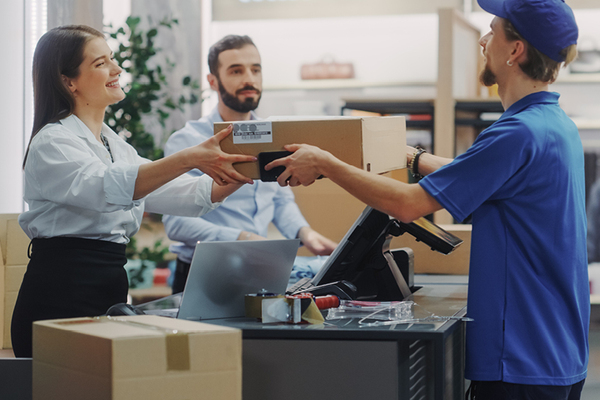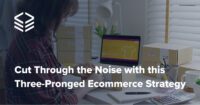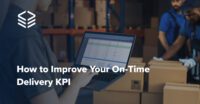
In-store order fulfillment is viewed by many as a benefit for retailers that want to expand their inventory throughput and meet customer demand. The strategy doesn’t come without its challenges, though. In-store fulfillment gained popularity during the early days of the pandemic and has been credited with allowing physical storefronts to hold margins steady during shutdowns.
Buy-online-pick-up-store (BOPIS) and gig delivery are two fulfillment models that have risen in popularity, though this fast-and-ready solution often overlooks the ways in which individual customers are affected.
While these models aid in expanding a brand’s ecommerce presence, they fails to consider the holistic customer journey. Ultimately, in-store fulfillment is a work-around, rather than a scalable solution for retailers.
What is in-store fulfillment?
In-store fulfillment is an omnichannel strategy implemented when a physical store serves as a mini, makeshift warehouse that processes online orders and makes them available for customer or gig-worker pick-up. However, the question isn’t only: what is in-store fulfillment? The better one to ask is: how does it affect brands and their consumers?
Why does in-store fulfillment fall short for both brands and consumers?
The strategy spiked in popularity due to the necessities associated with the Covid-19 pandemic, but in-store fulfillment isn’t meant to be a long-term solution. It falls short in several ways which disrupt the customer experience and derail retailers’ best efforts.
Inventory inaccuracy
Physical storefront systems aren’t equipped to handle expansive fulfillment networks and complex distribution center processes. There’s no way to track in-store shopping for every item that’s pulled off the shelf in real-time, which leaves partially filled orders and/or replacement product recommendations that aren’t exactly what the customer ordered. When it comes to order management and inventory accuracy, they definitely suffer.
Inconsistent demand forecasting
Due to network challenges to secure consistent demand forecasting, retailers must juggle inventory across both store types and allocate inventory accordingly. The attempt to balance in-store inventory with ecommerce product demand has led to stock inaccuracy and increased out-of-stock on products in the highest demand.
Higher picking costs
The immediacy of in-store order fulfillment often ends up being costlier without providing any greater value to customers as a result. In-store picking costs are typically 1.5 to 2 times higher than fulfillment center picking costs. With ecommerce becoming consumers’ main purchase mode, brands must consider the entire customer experience, which can’t be satisfied with a temporary fix.
Poor execution
The surge of in-store fulfillment was during a time of prolonged uncertainty, which means many areas weren’t optimized for efficiency. The result? Poor execution and increasing frustrations. Everything from parking lots crowded with BOPIS, cashiers fulfilling orders versus being available for in-store shoppers, and inconsistencies with last-mile delivery through services like Instacart and DoorDash have all made for a less-than-desirable customer experience.
What are the advantages of in-store fulfillment as part of your ecommerce selling process?
When viewing in-store fulfillment as part of a comprehensive strategy, it has a better chance of success versus relying solely on the method for ecommerce growth. Here are both advantages and disadvantages to consider for your brand.
Advantages
Evolution of Brick-and-Mortar
Retailers have evolved their brick-and-mortar shops to meet the demand of ecommerce as consumers’ main purchasing mode. It provides an opportunity to fulfill customers’ needs in the quickest, most convenient way possible without extra cost to them.
Expands Ecommerce Base
Certain retailers have adopted the in-store fulfillment model to reach markets where it does not currently house retail stores as a way to expand their ecommerce base.
Disadvantages
Stepping into the next phase of ecommerce shopping with in-store fulfillment is conceptually harder to execute consistently. It can be incorporated successfully as part of a comprehensive ecommerce plan, but it’s lacking on its own.
Store Disruption
In-store fulfillment virtually “cuts in line” of in-store shoppers who often experience bare shelves and bigger crowds at the grocery store due to gig workers and onsite personnel picking items for orders that have been placed online. There’s also parking space and pick-up confusion, as well as inaccuracy in inventory allocation, leaving customers consistently disappointed.
Poor Customer Experience
In-store fulfillment models like BOPIS benefit the retailer by outsourcing the delivery to customers themselves who are then responsible for the logistics of pick-up and delivery. It also forces store employees to allocate time to search and set aside products, confirm customer orders, and reshelve items when customers cancel orders or miss the pick-up window. This takes away from the customer experience on all levels as store employees struggle to keep up.
How does in-store fulfillment differ from an ecommerce-specific center for online orders? Is one better than the other?
As ecommerce evolves, “brick and mortar” will come to mean ecommerce-specific fulfillment centers, not retail stores, when it comes to online orders. It’s an untenable expectation that in-store fulfillment can support both online and in-person transactions.
Ecommerce-specific fulfillment centers involve designating physical spaces for ecommerce orders only, a solution that establishes accurate inventory levels better suited for long-term ecommerce success. This strategy and/or the implementation of an outsourced ecommerce fulfillment solution addresses the problems and inefficiencies associated with standard in-store fulfillment practices.
Ecommerce-specific fulfillment centers for customer convenience
One example is with grocers like Kroger, which recently launched delivery services through an automated customer fulfillment center and services shoppers within a 90-mile radius. Instacart is also transitioning toward the e-commerce specific center model, resulting in less elbow-to-elbow shopper competition in the grocery aisles.
Outsourced fulfillment solutions for scalability
Using Flowspace as an outsourced ecommerce order fulfillment solution allows ecommerce sellers to scale and optimize the entire supply chain and improve the customer experience. Through omnichannel inventory visibility and fulfillment, it empowers brands to continuously meet and exceed expectations as it supports overall business growth.
Choosing the right fulfillment solution for your brand considering today’s trends in consumerism
Retailers must consider the impact of their ecommerce strategies as it pertains to the holistic customer experience and ever-evolving technology trends in ecommerce. Flowspace is equipped with the capabilities to meet fluctuating demand through a software platform that prioritizes customer satisfaction.
The centralized fulfillment technology platform powers the entire post-purchase experience, from the time an online order is placed until it reaches a customer’s front door. Ecommerce brands can rely on Flowspace as a scalable solution that will keep them from falling short in the ways in-store fulfillment often can and consistently meet customer expectations while strategically growing their business.
Want to learn more about how Flowspace can optimize your fulfillment strategies?
Sources:
- McKinsey. Retail’s need for speed: unlocking value in omnichannel delivery. https://www.mckinsey.com/industries/retail/our-insights/retails-need-for-speed-unlocking-value-in-omnichannel-delivery
- Supply Chain Dive. Kroger officially launches delivery services in Atlanta. https://www.supplychaindive.com/news/kroger-starts-ocado-delivery-atlanta/616607/






